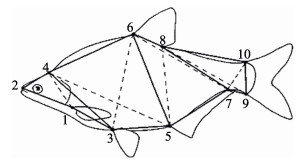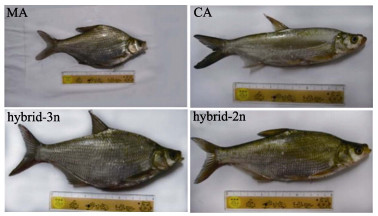团头鲂(Megalobrama amblycephala)和翘嘴鲌(Culter alburnus)是中国重要的养殖经济鱼类,分别属于鲤科(Cyprinidae)、鲌亚科(Culterinae)中的鲂属(Megalobrama)和鲌属(Culter)。团头鲂杂食偏草食性,生长速度快,养殖成本低;翘嘴鲌体型细长,肉食性,肉质细嫩鲜美,鳞片薄且细小,易脱落易受伤,生长慢,饲养成本高(农业农村部渔业渔政管理局等, 2020)。虽然二者在食性、生长和抗逆性等性状大不相同,但有很大的性状互补性。杂交可以将双亲优良性状集于一身(周华兴等, 2021),但这种优势通常只限于F1代。理论上讲,在三倍体生长和发育期间,由于性腺几乎不发育,可以保持F1代杂种优势,避免继续繁殖造成的种质衰退,节省的能量将用于加速生长和提高肌肉品质(王雪薇, 2017),这无疑将大大拓展“鲂鲌”杂交新品种的养殖空间,产生较大的经济、社会和生态价值。
近年来,本课题组开展团头鲂(♀)×翘嘴鲌(♂)杂交三倍体的静水压诱导实验,获得了鲂鲌三倍体[高三倍体率(> 80%)和高成活率(> 98%)]和鲂鲌二倍体,初步观察三倍体具有较强的生长优势。鲂鲌三倍体与二倍体形态类似,外观难以区分,因此,形态分析对种群鉴定与后续选育具有重要意义。目前,开展的杂交实验中与团头鲂、翘嘴鲌相关的形态研究已有记载,如关文志等(2017)对团头鲂、三角鲂(M. terminalis)、长春鳊(Parabramis pekinensis)及其杂交后代共7个群体的形态进行了比较分析;郭洪洪等(2018)对三角鲂、团头鲂、翘嘴鲌及其杂交后代5个群体的形态差异进行了分析;刘加林(2020)对翘嘴鲌和三角鲂亲本及其杂交后代太湖鲂鲌(C. alburnus♀× M. terminalis♂)的形态特征进行了分析;但对经静水压诱导的团头鲂(♀)×翘嘴鲌(♂)杂交后代的形态研究尚未见报道。
本研究通过生长对比实验比较分析鲂鲌三倍体、二倍体及其双亲自交后代4种鱼的生长性能,并运用传统形态学测量法结合现代框架结构测量法对4种鱼的形态进行统计,同时应用多元统计分析法对数据进行分析以探究4种鱼之间的形态差异,旨在为鲂鲌杂交后代种群鉴定及选育提供基础资料。
1 材料与方法 1.1 亲本催产、人工受精及孵化2021年5月,静水压诱导的团头鲂(♀)×翘嘴鲌(♂)杂交实验在农业农村部团头鲂遗传与育种中心进行。母本为团头鲂“浦江2号”F6代,父本为淀山湖翘嘴鲌F3代,均来自农业农村部团头鲂遗传与育种中心,均为性腺发育良好、体格健壮、形体优美的3龄鱼。于傍晚进行催产药物(10 μg HCG+200单位LHRH- A2/kg)注射,雄鱼剂量减半,将亲鱼安置于深1.3 m、半径1 m的圆形产卵池中,保持池中流水状态。翌日清晨,待亲本能挤出卵子和精子时,迅速捞起亲鱼,在避光环境下挤压亲鱼腹部取卵子和精子于盆中,进行人工干法授精,随后用滑石粉进行脱黏处理。经过静水压力(受精后处理起始时间为2~3 min,压强为35~50 MPa,持续时间为3 min)处理后,于孵化桶中孵化受精卵,直至鱼苗可以正常平游再转移到深1.5 m的600 m2大土塘中。从受精、孵化到苗种培育整个过程的水温控制在22~24 ℃。待鱼苗长至3~5 g时通过Partec倍性分析仪区分出鲂鲌三倍体和二倍体,分别用hybrid-3n和hybrid-2n表示。同时建立团头鲂×团头鲂、翘嘴鲌×翘嘴鲌2个自交群体,后代分别用MA和CA表示。
1.2 生长对比生长对比实验于2022年3月中旬开始,将1.1中4个群体分别记录初始体重W0并剪鳍条以区分(hybrid-3n:左胸;hybrid-2n:右胸;MA:左腹;CA:右腹),而后转移至新的深1.5 m的600 m2大土塘中同池混养,整个养殖过程均使用相同的鱼用配合饲料(粗蛋白31.0%、粗纤维12.0%、粗脂肪8.0%),且每周换水1次保持养殖水体清爽(pH为6.8~7.6,溶解氧 > 5.5 mg/L,氨氮 < 0.5 mg/L)。2022年10月中旬对全池拉网起捕,进行体质量测定以比较生长速度。
绝对增重率AGR(g/d)=(W1−W0)/(t1−t0),其中,W1和W0分别对应时间t1和t0时的体质量,t1−t0为210 d。变异系数CV=标准差/平均值×100%。
1.3 测量方法2022年12月上旬拉网,在每个群体中都随机取30尾进行计数与测量。对背鳍条、胸鳍条、腹鳍条、臀鳍条、侧线上鳞、侧线下鳞和侧线鳞7项可数性状计数,对体质量、全长(La)、体长(Lb)、体高(Lc)、头长(Ld)、吻长(Le)、眼间距(Lf)、眼径(Lg)、尾柄高(Lh)、尾柄长(Li)、背棘长(Lj) 11项可量性状与20项框架结构数据(陈杰等, 2014)进行测量(图 1)。数据测定使用电子游标卡尺,精度为0.01 cm。体质量用电子天平,精度为0.1 g。

|
图 1 框架结构定点图 Fig.1 Fixed point diagram of frame structure 1. 胸鳍起点;2. 吻前端;3. 腹鳍起点;4. 头背部末端;5. 臀鳍起点;6. 背鳍起点;7. 臀鳍未端;8. 背鳍未端;9. 尾鳍腹部起点;10. 尾鳍背部起点。 1. Origin of pectoral fin; 2. Tip of snout; 3. Origin of pelvic fin; 4. Terminus of head back; 5. Origin of anal fin; 6. Origin of dorsal fin; 7. Terminus of anal fin; 8. Terminus of dorsal fin; 9. Ventral origin of caudal fin; 10. Dorsal origin of caudal fin. |
为避免鱼体规格对形态参数造成统计误差,将所有可量性状数据转变成比例性状数据,得到9项(郭洪洪等, 2018),框架结构数据转变成和体长的比例数据。基于可数性状和9项比例性状数据计算团头鲂(♀)×翘嘴鲌(♂)的杂种指数(hybrid index, HI) (Witkowski et al, 1980; Cricelli et al, 1988)。HI=100×(Hi−Mi1)/(Mi2−Mi1),其中,Hi为杂种平均值;Mi1为母本平均值;Mi2为父本平均值。HI在45~55之间属中间性状,HI > 55为偏父本性状,HI < 45为偏母本性状,HI > 100或者HI < 0为超亲偏离性状。采用SPSS 26对每个可量性状和9个比例性状作单因素方差分析(one-way ANOVA),LSD法多重比较进行显著性检验,P < 0.05为差异显著。对9个可量比例参数和20项框架比例参数共计29项做聚类分析(欧式距离的最短系统聚类法)、判别分析(逐步判别法)和主成分分析(张尧庭等, 1982)。
2 结果 2.1 形态特征4种鱼的主要形态特征比较见图 2。仔细观察可以看出,hybrid-3n的形态特征与hybrid-2n较为相似,尤其头部非常相像,皆明显大于双亲自交后代,嘴部皆上翘但不如CA明显。hybrid-3n体长与CA和hybrid-2n都较为相似,但体高明显增加趋向母本MA。hybrid-3n背部略微隆起,较hybrid-2n更为明显,与MA相似,而CA背部较为平整。hybrid-3n背部和侧上方为青灰色,腹部与侧下方为银白色,鳞片较大类似MA,薄软情况类似CA。

|
图 2 杂种三倍体、杂种二倍体及其双亲自交后代的形态 Fig.2 Morphology of hybrid triploid, hybrid diploid and double inbred offspring |
经过210 d饲养,剪去的鳍条清晰可见不存在错分可能,以绝对增重率反映生长速度,hybrid-3n生长速度[(0.88±0.11) g/d]较hybrid-2n提高8.64%,较MA提高20.55%,较CA提高120.00%,表明hybrid-3n更具生长优势(表 1)。
|
|
表 1 杂种三倍体、杂种二倍体、团头鲂和翘嘴鲌的生长速度比较 Tab.1 Comparison of growth rates of hybrid triploid, hybrid diploid, M. amblycephala and C. alburnus |
4种鱼可数性状表现如表 2所示,可见hybrid-3n和hybrid-2n的臀鳍条、侧线上鳞、侧线下鳞和侧线鳞数4项均介于双亲之间,在侧线上鳞、侧线下鳞和侧线鳞数上,4个群体皆差异显著(P < 0.05)。杂种指数显示,hybrid-3n背鳍和胸鳍为偏父本性状;其他5个性状为偏母本性状。hybrid-3n和hybrid-2n杂种指数平均值分别为41.05和36.07,接近中间值,均略偏向于母本MA。
|
|
表 2 杂种三倍体、杂种二倍体及其双亲自交后代的可数性状数据 Tab.2 Countable character data of hybrid triploid, hybrid diploid and their progenies of double inbreeding |
结果如表 3所示,hybrid-3n群体除全长/体长(La/Lb)、体长/尾柄长(Lb/Li)、尾柄长/尾柄高(Li/Lh)外,其余6个性状与母本差异显著(P < 0.05);与父本除体长/头长(Lb/Ld)、头长/眼径(Ld/Lg)外,其余性状皆有显著性差异(P < 0.05);与hybrid-2n群体只在体长/尾柄长(Lb/Li)、尾柄长/尾柄高(Li/Lh)差异不显著(P > 0.05)。其中,在体长/体高(Lb/Lc)、头长/眼间距(Ld/Lf)、体长/背棘长(Lb/Lj)这3个性状上4个群体均有显著性差异(P < 0.05)。
|
|
表 3 杂种三倍体、杂种二倍体及其双亲自交后代的可量性状数据 Tab.3 Quantitative character data of hybrid triploid, hybrid diploid and their progenies of double inbreeding |
杂种指数显示,hybrid-3n没有表现出超亲偏离,体长/背棘长(Lb/Lj)为中间性状,体长/头长(Lb/Ld)、头长/眼径(Ld/Lg) 2个性状偏向父本,其余6项偏向母本。hybrid-3n和hybrid-2n杂种指数平均值分别为36.73和57.57,显示在可量性状比值上hybrid-3n群体偏向于母本MA,hybrid-2n群体略偏向于父本CA。
2.5 聚类分析hybrid-3n首先和hybrid-2n聚在一起归为一类,然后再与母本MA聚为一支,最后再与父本CA聚在一起。表明hybrid-3n和hybrid-2n在可量性状和框架结构上受母本的影响要大于父本(图 3)。

|
图 3 杂种三倍体、杂种二倍体、团头鲂和翘嘴鲌的形态聚类树形图 Fig.3 Morphological clustering tree diagram of hybrid triploid, hybrid diploid, M. amblycephala and C. alburnus |
运用逐步判别分析法剔除无显著性差异(P > 0.05)的性状,筛选出11个极显著性差异的生物学性状(P < 0.01):体长/体高(Lb/Lc)、头长/眼径(Ld/Lg)、L6~5/Lb、体长/头长(Lb/Ld)、L4~3/Lb、L5~7/Lb、头长/吻长(Ld/Le)、L4~1/Lb、L4~5/Lb、L7~9/Lb、头长/眼间距(Ld/Lf),分别以X1~X11表示,构建的判别方程式如下:
hybrid-3n:Y1=–3373.274+1687.653X1–271.121X2+ 1114.458X3+5470.034X4+2226.751X5+699.818X6+247.389 X7+277.876X8+103.301X9+65.103X10+260.495X11
hybrid-2n:Y2=–3531.189+1626.448X1–319.090X2+ 915.873X3+5872.903X4+2236.466X5+610.081X6+247.127 X7+288.498X8+112.040X9+67.128X10+270.256X11
MA:Y3=–3343.923+1843.445X1–527.639X2+ 740.523X3+5804.654X4+1894.388X5+1009.327X6+257.035X7+268.989X8+128.266X9+40.828X10+247.084X11
CA:Y4=–3646.496+871.390X1–233.509X2+ 1775.813X3+5563.526X4+2200.800X5+1232.343X6+346.323X7+247.134X8+74.288X9+79.490X10+245.705X11
运用以上判别方程式就可以判断某尾鱼的群体归属,将待测鱼的上述11个形态数据分别代进各判别方程式,结果最大的即为该鱼的归属。判别分析结果见表 4,仅在hybrid-3n和hybrid-2n群体中出现误判,对hybrid-3n和hybrid-2n群体的判别准确率都为90%,hybrid-3n中有3个样本误判为hybrid-2n,hybrid-2n中有3个样本误判为hybrid-3n;综合判别率达95%。
|
|
表 4 杂种三倍体、杂种二倍体、团头鲂和翘嘴鲌的判别结果 Tab.4 Discriminant results of hybrid triploid, hybrid diploid, M. amblycephala and C. alburnus |
4个群体120个样本的分布如图 4所示,MA和CA群体分别处于图中两端,hybrid-3n和hybrid-2n的群体中心位于父母本之间但更靠近母本MA,且hybrid-3n群体中心相比hybrid-2n要更接近母本。hybrid-3n和hybrid-2n二者所占区域有部分重叠,表明二者在比例性状和框架结构上形态十分接近,不易区分。

|
图 4 三倍体、二倍体、团头鲂和翘嘴鲌的判别分析图 Fig.4 Discriminant analysis diagram of triploid, diploid, M. amblycephala and C. alburnus |
共获得4个主成分,对变异的累计贡献率为75.10%,占据了群体总变异的大部分。主成分的成分载荷矩阵分析发现,主成分1 (52.87%)主要取决于L6-5/Lb、L8-5/Lb、L5-7/Lb、L6-3/Lb、体长/体高(Lb/Lc)、L4-1/Lb、L6-7/Lb、L2-4/Lb、L4-3/Lb、头长/眼间距(Ld/Lf)、L10-9/Lb、L6-8/Lb、尾柄长/尾柄高(Li/Lh)、体长/背棘长(Lb/Lj)、头长/吻长(Ld/Le)、L7-9/Lb和L8-7/Lb,这17项参数指标其载荷绝对值皆大于0.7,主要是对鱼体体高的形态差异表现。对主成分2 (10.06%)起主要作用的参数指标有L1-3/Lb、L8-9/Lb、L3-5/Lb和L4-5/Lb,这4项比例参数载荷绝对值皆大于0.5,主要是对鱼体躯干的形态差异表现。主成分3 (7.08%)和主成分4 (5.09%)分别主要体现了鱼体尾部和头部的形态差异。由此可见,hybrid-3n、hybrid-2n、MA和CA四个群体在形态上的差异主要表现在鱼体体高和躯干处。
3 讨论 3.1 鲂鲌三倍体的生长优势三倍体鱼类因染色体组数为奇数致使减数分裂出现异常,表现出不育或败育(李宝玉, 2021),理论上,这将使得原本用于性腺生长发育的能量转而被用来加速个体的生长。Utter等(1983)研究发现,银大马哈鱼(Oncorhynchus kisutch)幼鱼三倍体的生长不如二倍体;Byamungu等(2001)研究发现,奥里亚罗非鱼(Oreochromis aureus)三倍体幼鱼生长速度不如二倍体;Artamonova等(2018)研究发现,细鳞大马哈鱼(O. gorbuscha)三倍体在成鱼时期生长性能明显不如二倍体。Purdom (1976)研究了异源杂交鲽(Pleuronectidae)三倍体和二倍体生长情况,发现二者不具备显著性生长差异;同样,Wolters等(1982)在斑点叉尾
形态是生物最直观的外在表现,其差异能直接反映生物多样性,是种群鉴定、分类的重要依据(尹洁等, 2020)。本研究可数性状分析发现,hybrid-3n和hybrid-2n平均杂种指数HI分别为41.05和36.07,均略偏向于母本MA。9项可量比例性状分析发现,hybrid-3n和hybrid-2n的多数可量性状变异较大,hybrid-3n与父本和母本分别有7项和6项存在显著性差异,hybrid-2n有6个比例性状分别与父母本有显著性差异。hybrid-3n和hybrid-2n杂种指数平均值分别为36.73和57.57,显示hybrid-3n可量性状比值偏向于母本,hybrid-2n可量性状比值偏向于父本,这与上述可数性状结果略有不同,可能是因为可量性状为连续性状,受环境影响更大,不如可数性状稳定(宋文, 2016)。
|
|
表 5 4个群体的主成分载荷矩阵及主成分的贡献率 Tab.5 Principal component load matrix and principal component contribution rate of four groups |
现今,已有众多的物种鉴定、育种及进化方面的研究都综合利用了各多元统计分析方法进行形态差异比较(梁述章等, 2018; 朱书琴等, 2021; 周华兴等, 2021; 马凯等, 2023)。本研究聚类分析显示,hybrid-3n首先和hybrid-2n聚在一起归为一类,然后与母本MA聚为一支,最后与父本CA聚在一起,表明hybrid-3n和hybrid-2n在可量性状和框架结构上更接近母本,表现出一定母性效应,类似于杂交种“云龙石斑鱼” (Epinehelus moara ♀ × E. lanceolatus ♂) (李振通等, 2019)、大口黑鲈(Micropterus salmoides♀)×蓝鳃太阳鱼(Lepomis mearchirus♂)杂交F1 (李武辉等, 2020)和团头鲂(♀)×长春鳊(♂)杂交F1 (赵博文等, 2015)等大多数杂交后代的整体形态表现。但也有杂交后代形态偏向父本的报道,如草鱼(Ctenopharyngodon idella♂) ×赤眼鳟(Spualiobarbus curriculus♀) F1 (金燮理等, 1999)和翘嘴红鲌(Erythroculter ilishaeformi♀)×团头鲂(♂) F1的形态特征(顾志敏等, 2008)。这种差异可能是母性效应在不同性状中表现不同,具体原因有待进一步探索。
本研究判别分析对hybrid-3n和hybrid-2n群体的判别准确率均为90%,对MA和CA判别准确率均为100%,4种鱼的综合判别率达95%,判别效果较好。可见hybrid-3n和hybrid-2n因形态相似,不可避免出现误判。判别分析散点图显示,MA和CA两群体分别占据不同区域,hybrid-3n和hybrid-2n的分布中心位于父母本之间且更靠近母本MA;hybrid-3n和hybrid-2n二者所占区域有部分重叠,表明二者在比例性状和框架结构上形态十分接近,不易区分。这些与聚类分析所得结果基本一致。构建判别方程式的11个生物学性状大多与身体纵轴相关尤其体现在与体高的比例上,躯干处也有涉及,这与主成分分析所得结果类似。
本研究主成分分析共获得4个主成分,累计贡献率为75.10%,可以较好概括4种鱼群体间的形态差异。其中,决定主成分1 (52.87%)特征向量绝对值较大的性状大多体现在与体高的比例上,这与易伯鲁(1955)的研究结果相符。此外,主成分2 (10.06%)中决定它的4项参数主要集中在鱼体躯干处,反映鱼体躯干处的形态特征也是鱼类变异的重要来源。何震晗(2021)对不同地理种群的黄鳍棘鲷(Acanthopagrus latus)进行主成分分析认为,它们的差异主要体现在鱼体躯干和尾部性状上;张秀霞等(2017)研究发现,唐鱼(Tanichthys albonubes)形态变异主要在眼径大小和头部;王新月等(2022)认为不同地理群体的叶尔羌高原鳅(Triplophysa yarkandensis)形态差异主要在机体头部和躯干前段。这些与本研究所得结果有异,可能是因为鱼类尾部是行进的重要器官,与游泳能力密切相关,鱼类头部与食性摄食密切相关;而躯干和体高可以反映是否有足够空间积累脂肪增加体重;另外,蔡鸣俊等(2001)认为,较大的体高可以减轻被凶猛鱼类吞噬的危险。本研究的实验鱼为静水池塘养殖,饵料丰富,与上述鱼类生活环境大不相同,因此,研究结果的异同可能是由于鱼类对生态环境的适应。
可见,本研究所用3种多元分析方法有效地从不同角度反映了hybrid-3n、hybrid-2n、MA和CA四个群体间的形态差异,这使得彼此之间不可替代。生物形态由遗传因子与环境共同决定(杨慧, 2016),本研究中4种鱼均同池混养,养殖环境相同,造成的形态差异可能更多的是遗传因子的反映。我们通过对4种鱼进行染色体核型分析认为hybrid-2n从母本和父本中各继承1n染色体,因母性效应而使形态偏向于母本,而hybrid-3n因静水压力对卵子第二极体排出的抑制从母本继承了2n染色体,从父本继承1n染色体而使得形态较hybrid-2n与母本更为接近。
综上所述,本研究证实了鲂鲌三倍体具有优越的育种潜力,并为鲂鲌杂交子代的形态比较提供基础数据对鲂鲌鱼类种群资源的鉴定保护具有积极意义,有望为优良鲂鲌新品系的建立提供理论基础。
ARTAMONOVA V S, PONOMAREVA M V, IGNATENKO V V, et al. Gonadal development of diploid and triploid pink salmon (Oncorhynchus gorbuscha) from the White Sea. Sibirskii Ekologicheskii Zhurnal, 2018, 25(3): 366-377 |
Bureau of Fisheries, Ministry of Agriculture and Rural Affairs, National Fisheries Technology Extension Center, China Society of Fisheries. China fishery statistical yearbook. Beijing: China Agriculture Press, 2020 [农业农村部渔业渔政管理局, 全国水产技术推广总站, 中国水产学会编制. 2020中国渔业统计年鉴. 北京: 中国农业出版社, 2020]
|
BYAMUNGU N, DARRAS V M, KUHN E R. Growth of heat-shock induced triploids of blue tilapia, Oreochromis aureus, reared in tanks and in ponds in Eastern Congo: Feeding regimes and compensatory growth response of triploid females. Aquaculture, 2001, 198(1/2): 109-122 |
CAI M J, ZHANG M Y, ZENG Q L, et al. A study on morphometrics of the genus Megalobrama. Acta Hydrobiologica Sinica, 2001, 25(6): 631-635 [蔡鸣俊, 张敏莹, 曾青兰, 等. 鲂属鱼类形态度量学研究. 水生生物学报, 2001, 25(6): 631-635 DOI:10.3321/j.issn:1000-3207.2001.06.014] |
CHEN J, LI F G, HUANG C X, et al. Morphological variations of genera Parabramis and Megalobrama teleost populations. Journal of Shanghai Ocean University, 2014, 23(3): 388-394 [陈杰, 李福贵, 黄创新, 等. 不同鳊鲂属鱼类群体的形态差异分析. 上海海洋大学学报, 2014, 23(3): 388-394] |
CRICELLI A, DUPONT F. Biometrical and biological features of Alburnus alburnus × Rutilus rubilio natural hybrids from Lake Mikri Prespa, northern Greece. Journal of Fish Biology, 1988, 31(6): 721-733 |
GILLET C, VAUCHEZ C, HAFFRAY P. Triploidy induced by pressure shock in Arctic charr (Salvelinus alpinus): Growth, survival and maturation until the third year. Aquatic Living Resources, 2001, 14(5): 327-334 DOI:10.1016/S0990-7440(01)01129-9 |
GU Z M, JIA Y Y, YE J Y, et al. Studies on morphological characteristics and genetic analysis of the hybrid F1, Erythroculter ilishaeformis♂×Megalobrama amblycephala♀. Journal of Fisheries of China, 2008, 32(4): 533-543 [顾志敏, 贾永义, 叶金云, 等. 翘嘴红鲌(♀)×团头鲂(♂)杂种F1的形态特征及遗传分析. 水产学报, 2008, 32(4): 533-543 DOI:10.3321/j.issn:1000-0615.2008.04.005] |
GUAN W Z, ZHENG G D, WU C B, et al. Comparative analysis of growth and morphological variations among Megalobrama amblycephala, M. terminalis, Parabramis pekinensis and their hybrids. Journal of Fishery Sciences of China, 2017, 24(1): 31-39 [关文志, 郑国栋, 吴成宾, 等. 团头鲂与三角鲂或长春鳊杂交后代的生长及形态对比分析. 中国水产科学, 2017, 24(1): 31-39] |
GUO H H, ZHENG G D, WU C B, et al. Growth performance and morphological characteristics analysis of the hybrid F1, Megalobrama terminalis (♀)×Culter alburnus (♂). Journal of Fisheries of China, 2018, 42(10): 1572-1581 [郭洪洪, 郑国栋, 吴成宾, 等. 三角鲂(♀)×翘嘴鲌(♂)杂交F1的生长性能及形态差异. 水产学报, 2018, 42(10): 1572-1581 DOI:10.11964/jfc.20170910978] |
HE Z H. Morphological and genetic diversity analyses of acanthopagrus latus from different geographical populations. Master's Thesis of Guangxi University, 2021 [何震晗. 不同地理种群黄鳍棘鲷形态学分析及遗传多样性. 广西大学硕士研究生学位论文, 2021]
|
HUSSAIN M G, RAO G P S, HUMAYUN N M, et al. Comparative performance of growth, biochemical composition and endocrine profiles in diploid and triploid tilapia Oreochromis niloticus L. Aquaculture, 1995, 138(1/2/3/4): 87-97 |
JIN X L, JIN H, WANG M L, et al. Comparison of genetic characteristics between the F1 hybrid (Ctenopharyngodon idella ×Squaliobarbus cursiculus) and its parents. Life Science Research, 1999, 3(4): 316-320 [金燮理, 金宏, 王明龙, 等. 草鱼×赤眼鳟F1与其亲本遗传性状的比较研究. 生命科学研究, 1999, 3(4): 316-320 DOI:10.3969/j.issn.1007-7847.1999.04.008] |
LI B Y. Study on induction under hydrostatic pressure, muscle quality and microsatellite genetic characteristics of triploid Megalobrama amblycephala. Master's Thesis of Shanghai Ocean University, 2021 [李宝玉. 团头鲂静水压三倍体的诱导、肌肉品质及微卫星遗传特征分析. 上海海洋大学硕士研究生学位论文, 2021]
|
LI W H, HU J, SUN C F, et al. Morphological and genetic characteristics of hybrid F1 derived from largemouth bass (Micropterus salmoides) (♀)×bluegill (Lepomis mearchirus) (♂). Journal of Fisheries of China, 2020, 44(8): 1225-1236 [李武辉, 胡婕, 孙成飞, 等. 大口黑鲈(♀)×蓝鳃太阳鱼(♂)杂交F1的形态及遗传特征. 水产学报, 2020, 44(8): 1225-1236] |
LI Z T, CHEN M L, TIAN Y S, et al. Analysis of the morphological differences between hybrid "Epinephelus moara ♀×E. lanceolatus ♂" and its parents. Progress in Fishery Sciences, 2019, 40(4): 73-83 [李振通, 成美玲, 田永胜, 等. 杂交种"云龙石斑鱼"与亲本的形态差异分析. 渔业科学进展, 2019, 40(4): 73-83] |
LIANG S Z, SONG W, ZHAO M, et al. Morphology of seven Collichthys lucidus populations near the coast of the Yellow Sea and East China Sea. Journal of Fishery Sciences of China, 2018, 25(3): 576-585 [梁述章, 宋炜, 赵明, 等. 黄海、东海近海七个棘头梅童鱼地理群体的形态差异分析. 中国水产科学, 2018, 25(3): 576-585] |
LIU J L. Analysis of genetic characteristics and construction of high-density SNP genetic linkage map of Megalobrama culteri of Taihu Lake. Master's Thesis of Nanjing Normal University, 2020 [刘加林. 太湖鲂鲌的遗传特征分析及其高密度SNP遗传连锁图谱构建. 南京师范大学硕士研究生学位论文, 2020]
|
MA K, TONG G X, ZHANG L L, et al. Multivariate analysis of Hucho taimen and Hucho bleekeri populations based on morphological characteristics. Journal of Fishery Sciences of China, 2023, 30(1): 1-10 [马凯, 佟广香, 张澜澜, 等. 哲罗鲑和川陕哲罗鲑群体多变量形态特征比较. 中国水产科学, 2023, 30(1): 1-10] |
PIFERRER F, BEAUMONT A, FALGUIERE J C, et al. Polyploid fish and shellfish: Production, biology and applications to aquaculture for performance improvement and genetic containment. Aquaculture, 2009, 293(3/4): 125-156 |
PURDOM C E. Genetic techniques in flatfish culture. Fisheries Research Board of Canada, 1976, 33(4): 1088-1093 DOI:10.1139/f76-136 |
SOLTAN M, HASSAAN M. A comparative study of growth, feed utilization and gonad development of diploid and triploid Nile tilapia, Oreochromis niloticus. Gene and Cell Therapy, 2017, 2(1): 1-6 |
SONG W. Studies on morphology and genetic structure of the genus Megalobrama and Parabramis. Doctoral Dissertation of Huazhong Agricultural University, 2016 [宋文. 鳊鲂属鱼类形态学与遗传结构研究. 华中农业大学博士研究生学位论文, 2016]
|
UTTER F M, JOHNSON O W, THORGAARD G H, et al. Measurement and potential applications of induced triploidy in Pacific salmon. Aquaculture, 1983(35): 125-135 |
WANG X W. Comparison of the difference in diploid and triploid female rainbow trout (Oncorhynchus mykiss) muscles. Master's Thesis of Northeast Agricultural University, 2017 [王雪薇. 二、三倍体雌性虹鳟肌肉生长差异比较. 东北农业大学硕士研究生学位论文, 2017]
|
WANG X Y, ZHANG Y J, LIU F, et al. Analysis on the morphological differences of Triplophysa yarkandensis in different geographic populations. Progress in Fishery Sciences, 2022, 43(6): 199-206 [王新月, 张永杰, 刘斐, 等. 叶尔羌高原鳅不同地理群体形态差异分析. 渔业科学进展, 2022, 43(6): 199-206] |
WEI K, CHEN C S, ZHENG W, et al. Growth comparison between diploid and triploid lenok Brachymystax lenok. Chinese Journal of Fisheries, 2019, 32(3): 1-4 [魏凯, 陈春山, 郑伟, 等. 二、三倍体细鳞鲑幼鱼生长特性的研究. 水产学杂志, 2019, 32(3): 1-4] |
WITKOWSKI A, BLACHUTAD J. Natural hybrids Alburnus alburnus (L. ) ×Leucuscus and Biebrza. Acta Hydrobiologica, 1980, 22(4): 473-487 |
WOLTERS W R, LIBEY G S, CHRISMAN C L. Effect of triploidy on growth and gonad development of channel catfish. Transactions of the American Fisheries Society, 1982, 111(1): 102-105 |
YANG H. Analysis of genetic diversity and evaluation of growth performance of three red tilapia populations. Master's Thesis of Nanjing Agricultural University, 2016 [杨慧. 3个红罗非鱼群体的遗传多样性分析及生长性能评价. 南京农业大学硕士研究生学位论文, 2016]
|
YI B L. Notes on Megalobrama amblycephala, Sp. Nov, a distinct species from M. terminalis (Richardson). Acta Hydrobiologica Sinica, 1955, 2: 115-122 [易伯鲁. 关于鲂鱼(平胸鳊)种类的新资料. 水生生物学集刊, 1955, 2: 115-122] |
YIN J, MOU X X, ZHANG C L, et al. Comparison of morphological and genetic characteristics of Conger myriaster populations in China. Journal of Fisheries of China, 2020, 44(3): 358-367 [尹洁, 牟秀霞, 张崇良, 等. 我国近海星康吉鳗群体的形态学、遗传学比较研究. 水产学报, 2020, 44(3): 358-367] |
ZHANG X X, ZHU Q Y, ZHAO J. Geometric morphometric analysis of body-form variability in populations of Tanichthys albonubes. Journal of Fisheries of China, 2017, 41(9): 1365-1373 [张秀霞, 朱巧莹, 赵俊. 利用几何形态测量学方法分析唐鱼群体的形态变异. 水产学报, 2017, 41(9): 1365-1373] |
ZHANG Y T, FANG K Q. An introduction to multivariate statistical analysis. Beijing: Science Press, 1982: 393-401 [张尧庭, 方开秦. 多元统计分析引论. 北京: 科学出版社, 1982: 393-401]
|
ZHAO B W, ZHAO H H, YANG Z H, et al. Morphological characteristics and gonadal development of Megalobrama amblycehala (♀)×Parabramis pekinesis(♂) hybrid. Journal of Huazhong Agricultural University, 2015, 34(4): 89-96 [赵博文, 赵鸿昊, 杨振华, 等. 团头鲂(♀)×长春鳊(♂)杂交F1代形态特征及性腺发育. 华中农业大学学报, 2015, 34(4): 89-96] |
ZHOU H X, DUAN G Q, HU Y T, et al. Analysis of morphological differences between differential body colors groups of hybrid yellow catfish. Fisheries Science, 2021, 40(5): 726-732 [周华兴, 段国庆, 胡玉婷, 等. 杂交黄颡鱼体色分化群体形态差异分析. 水产科学, 2021, 40(5): 726-732] |
ZHU S Q, ZHAO J L, ZHOU Y H, et al. Morphometric differences between mandarin fish Siniperca chuatsi and bigeye mandarin fish S. kneri and their intermediate form in the middle reaches of the Changjiang River. Fisheries Science, 2021, 40(4): 530-536 [朱书琴, 赵金良, 周云红, 等. 长江中游湖泊翘嘴鳜、大眼鳜与其"中间类型"的形态学差异. 水产科学, 2021, 40(4): 530-536] |
ZOU Y C, LI Z, LI Y, et al. Induction and growth of triploid snakehead (Channa argus). Chinese Journal of Zoology, 2017, 52(1): 75-84 [邹远超, 李中, 李艳, 等. 乌鳢三倍体诱导及其生长. 动物学杂志, 2017, 52(1): 75-84] |



